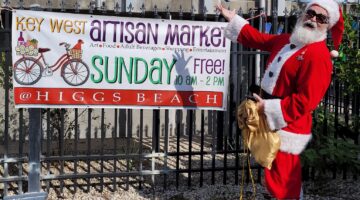Florida Keys images snap pair of first place awards in national contest

Daniel Eidsmoe will sacrifice for his art, even if it means hiking to the seashore at 3 a.m. to capture just the right angle of the Milky Way over the Florida Keys backcountry. And battling mosquitoes. All of it paid off when Eidsmoe’s long-exposure image captured first place in the recreation category of an annual contest sponsored by the Office of National Marine Sanctuaries.
“When I moved to the Keys I had no idea you could see the stars so well,” said Eidsmoe, 62. “Outside of scuba diving and kayaking it’s one of my favorite things about the Keys. I never saw the Milky Way when I was in Chicago. Even growing up in Iowa. The stars make the Keys just one more reason to live here.”
Living the dream
Eidsmoe lives in Marathon, fully-retired from a 32 year-career as a corporate attorney. Following law school, he had his heart set on becoming an F.B.I agent but color-blindness derailed his physical exam. Eidsmoe has been aware of the condition since elementary school, when teachers noticed he colored the sky green and the grass blue. But lacking a full range of color has only enhanced his sense of composition. Eidsmoe submitted ten photos in this year’s contest, an array of scenes captured at night from land, underwater and above from a drone. An aerial image of his wife flying a kite over a sandbar earned him a second-place finish in the sanctuaries at home category.
“When I lay down to sleep at night, I think about pictures I want to take, and I had contemplated that one for some time,” Eidsmoe said of the drone image.
The first-place photo required a hike through the mangroves toward a spot at Coco Plum Beach near Curry Hammock State Park. The tent was deployed to fend off mosquitoes and illuminated with a dive light. Once the framing was set, Eidsmoe waited for the stars to align, literally, then engaged his camera for a ten-second delay and took his mark at the water’s edge with a flashlight angled toward the sky. It required 30 seconds of exposure to secure the image, and some seventy mosquito bites his wife later counted on his back.
Small ball
Another Keys’ photo captured first place in the sanctuary life category, when Gabriel Jensen snapped an extreme close-up of an arrow crab posed in front of a sea urchin. A self-described “magnification maniac” who calls underwater photography the best hobby on the planet, Jensen scuba dives from land in nearshore waters looking for details most would pass over. “The arrow crab is a large subject compared to what I normally look for,” Jensen said of the two-inch crustacean. “I spend a lot of time photographing sea slugs, which are a centimeter to a half-centimeter in size, so the arrow crab was a giant.”
Jensen is a chemist by training and based in Ft. Lauderdale, but comes to the Keys in search of off-the-path locations. “Everyone thinks of the marine sanctuary as the reefs, but this photo is from that intersection of where the mangrove habitat meets those old cutaways on the backside of marinas.”
The day he nabbed the award-winning photo, Jensen was practically onshore, swimming along the seawall of an abandoned marina in the upper Keys. The vertical lines of the crab set against the vertical lines of the urchin created an interesting composition, or so said his wife, who works at the Coral Restoration Foundation.
“My wife stopped me when I was looking through pictures of the day. She’s tired of looking at sea slugs and says ‘that looks great.’”
Jensen’s work also earned a pair of honorable mentions in the contest but, alas, recognition is the only reward for him and Eidsmoe. The Office of National Marine Sanctuaries will feature the images in the next edition of its Earth is Blue social media campaign. For more, visit sanctuaries.noaa.gov.
[livemarket market_name="KONK Life LiveMarket" limit=3 category=“” show_signup=0 show_more=0]

No Comment